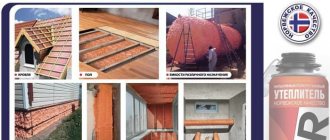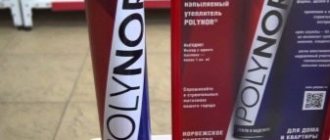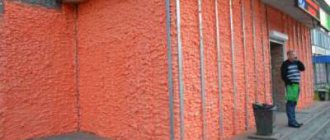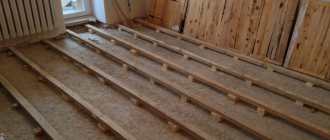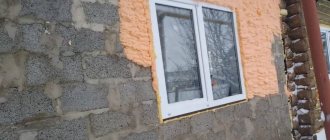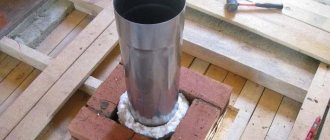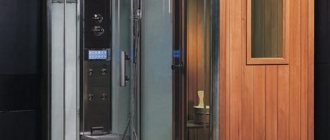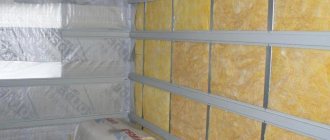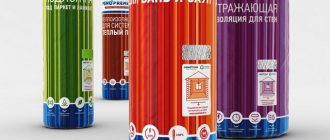Issues related to improving the energy efficiency of buildings have come to the fore in recent years. An urgent task is the choice of materials for construction, as well as the choice of a method for thermal insulation of a house, while certain requirements for thermal conductivity, flammability, environmental friendliness, weight and other parameters are imposed on the insulation.
One of the optimal options for thermal insulation of a house can be considered polyurethane foam insulation , which is applied over the entire surface in a continuous layer, which practically eliminates the formation of cold bridges.
There is a similar article on this topic - Insulation of the foundation and basement outside the house.
Scope of application
The description of the insulation presents us with a modern, almost universal material, which has a fairly wide application as a finishing and insulating material, in particular:
- for facades for finishing;
- for foundations and attics;
- for balconies;
- for insulation of internal walls of a building, partitions in various buildings;
- to isolate communication systems;
- in vehicles with isothermal functions.
As you can see, the application is wide. And this is understandable, since the heat insulator has good performance properties, fits perfectly on any surface, is very flexible and is not subject to destruction, even if a crack appears on the surface. The material is non-toxic and perfectly absorbs sound and vibration waves.
Professional advice and customer reviews
Over several years of use, Polinor insulation has already managed to win admirers. Many professionals who have been using polyurethane foam for a long time have given their preference to the new product. It is noted that it is extremely easy to install, fits perfectly on any surface and has good characteristics during operation. Thermal insulation occurs quickly and at a high level.
It is also noted that the material is extremely toxic, so you should take precautions and protect yourself with special suits, gloves, respirators and goggles. If foam gets on the surface of the skin, rinse it thoroughly and consult a doctor.
Also, consumer reviews note that Polinor insulation is quite expensive in cost, but this factor should not be decisive when choosing insulation. The speed of application and excellent characteristics will allow you to save significantly on heating the room in the future.
The material is extremely toxic, so precautions should be taken
Professionals also often prefer this material. Its light structure and ease of application can significantly reduce the time and money spent on installing insulation.
How to choose from all the varieties
The choice of type of insulation depends on the situation, as well as the area of application; let’s consider some common cases in which foam insulation is used:
- You can use polyurethane if you need to repair cracks or eliminate other defects on the walls. Do not expose it to direct sunlight.
- To fill large volumes, use penoizol. In this case, it is necessary to purchase a special high-pressure apparatus, since a regular cylinder will not be enough for this.
- To seal cracks and thermally insulate a small surface area, select mounting samples in cylinders. It does not ignite when interacting with fire, does not support combustion, has an environmental composition and hardness after hardening.
Remember! Polyurethane foam is categorically not suitable for insulating the entire building, since it does not have the appropriate characteristics.
To eliminate defects that have been detected externally, foam, which contains polyurethane, is applied using direct method technology, using a machine or a special cylinder. Errors within the layer that foam insulation creates require a long hose to push the material through. To fill the air gaps inside the insulation, holes are made in the wall.
Release form
Sprayed insulation has been known since 2013. It is a one-component self-expanding mixture with a closed-cell structure.
In construction stores, this thermal insulation is sold in cylinders similar to conventional foam for a gun.
It is applied in the same way as construction foam. According to reviews, one cylinder is enough for a 5-centimeter layer of insulation over an area of one square meter. The manufacturer's instructions state that the service life, in the absence of exposure to negative factors, will be at least 35 years.
Possibility of using foam fillers
Then manufacturers began to produce sprayed insulation in compact-sized cylinders, which led to a reduction in the cost of the method. To spray such a mixture of steel, complex installations and specialists in thermal insulation finishing are not needed, since the material itself is filled into small containers and the possibility of manual spraying is provided. Each cylinder is designed to cover one square meter of base (layer up to 60 mm thick). One person can process up to one hundred square meters per day.
As a result, calculations showed that working with insulation such as Polynor is much more profitable in terms of labor costs, costs for the materials themselves and surface preparation. If a professional team of workers charges up to one and a half thousand rubles for insulating one square of wall, then using Polinor insulation with the same amount of material, you need to spend only about 500 rubles. You can work independently, which eliminates the need to look for experienced workers, reduces finishing time, and saves money.
The choice of thermal insulation of this type remains the only optimal option that is available to people without special training. Foam can be used to create insulation for foundations, basements, walls inside and outside buildings made of brick, stone, concrete, and blocks. This option is also suitable for thermal insulation of non-load-bearing coatings, including floors on joists, as well as pitched roofs and attic floors.
Since Polinor is suitable for application to bases made of almost any material, it can be used as thermal insulation for plumbing fixtures and sewer pipes or fittings. In such cases, foam insulation in cylinders can be used indoors or in open areas. There is only one limitation on the use of balloon thermal insulation, which is that the material cannot be used to foam voids. It can only be applied to a dense base.
https://youtube.com/watch?v=HzNxMCfzjrE
Properties and scope
It should be noted that in general, insulation materials based on polyurethane foam are somewhat inferior to their classic counterparts in terms of affordability. For this reason, these thermal insulation materials have not yet become as widespread as insulating building materials made from mineral wool, expanded polystyrene and polystyrene, the production of which is based on the extrusion method.
The issue of availability of polyurethane insulation materials for purchase is explained by the fact that the thermal insulation of a house requires a fairly large consumption of foam insulation. Until recently, this problem was solved by involving various contractors or by attempting to solve it independently through the acquisition of raw materials and special equipment, as well as the need to personally master thermal insulation technology.
The appearance of Polynor insulation on the market radically changed the situation. Now, to insulate any, even very large surface, the consumer does not need to resort to the services of third-party contractors and spend money on purchasing expensive equipment.
Liquid foam insulation Polynor is produced by the manufacturer in compact cylinders. The consumption of the contents of one such cylinder, provided that a heat-insulating layer 6 cm thick is created, is equal to 1 m² of the surface area being treated. At the same time, a comparison of the cost of Polynor thermal insulation sprayed from a cylinder with the costs of paying for the services of a third-party organization for home insulation clearly indicates in favor of the option of spraying liquid insulation.
It is known that the average cost of insulating 1 m² of polyurethane foam insulation by a team of specialists is approximately 1 thousand rubles, taking into account the cost of the material and the work performed. Whereas one cylinder of Polynor insulation for the same square meter of insulated surface area of a gable or attic will cost the consumer approximately 500 rubles.
This type of heat insulator is recommended for insulating rooms from the inside or outside by applying it to the internal surfaces of walls and facades of houses made of any material - brick, concrete or made of gas silicate blocks. This also includes log floors and any coverings with a structure that does not support dynamic loads. This heat insulator can be used to insulate the internal surfaces of pitched roofs, attics, attic floors, foundations, plinths and basement floors of buildings.
Thanks to Polynor's liquid form, it can be applied to absolutely any surface. Therefore, this material is successfully used for insulating sewer pipes and mains for both hot and cold water supply, located outside construction sites.
It should be taken into account that the operational capabilities of this insulation are somewhat limited by the balloon form of its release, which does not allow creating a pressure level that allows foaming voids inside hollow walls, that is, this material is only suitable for external spraying. Regarding the issue of labor productivity when working with this material, according to reviews from those consumers who have already used it, within one working day one person can process about 80–100 m² of insulated surface with Polynor.
In addition to the convenience and simplicity in the process of work and the high efficiency of sprayed thermal insulation of the Polynor brand, one can also highlight its key advantages over analogues from other manufacturers, such as the ability to quickly harden, no more than one hour, and the absence of a negative impact of this material on human health.
Polynor insulation does not attract rodents as a food source. It does not create cold bridges and, despite being extremely efficient, does not require special expensive equipment for its installation. The closed cells of this durable material do not allow moisture and steam to pass through, and in the absence of direct contact with fire it is capable of self-extinguishing.
Advantages and disadvantages
There are no ideal materials among insulation materials; all have not only advantages, but also disadvantages. Polyurethane foam material has a number of advantages over other heat insulators:
- Low thermal conductivity. Polyurethane foam is a good barrier to heat loss. It is perfect for internal thermal insulation, as it is enough to apply a small layer of foam.
- Waterproofing properties. The composition of the material allows it to be used as waterproofing. It perfectly protects against corrosion.
- No seams. The method of applying insulation (spraying) allows you to obtain a seamless layer. There are no joints formed in the areas where the foam adheres, through which the cold passes.
- High adhesion. The insulation adheres well to any building materials, the surface of which has been previously cleaned of debris, dust and degreased.
- Chemical neutrality. Polyurethane foam does not react chemically with other building materials and installation solutions. The insulation layer is resistant to aggressive chemicals (except petroleum products).
- High strength. After the foam polymerizes, it becomes so strong that it can withstand strong mechanical loads. It can even be used to insulate foundations that are buried in the soil. During operation, polyurethane also shows high strength.
- Fire safety. Due to the fact that the composition includes a fire retardant, this insulation has been awarded a fire safety certificate. The material not only ignites poorly, but also contributes to the self-extinguishing of fire.
- Long service life. Polyurethane does not absorb water, thanks to which it is not destroyed by adverse weather conditions and temperature changes (with the exception of ultraviolet rays). If all conditions were met during installation, it will retain its high technical characteristics for at least 50 years.
- Easy to install. Any craftsman can handle spraying insulation; there is no need to nail down brackets or install sheathing.
Disadvantages of sprayed polyurethane insulation:
- The material is characterized by low ultraviolet resistance. When irradiated, the structure of polyurethane foam disintegrates, so it is always protected from the outside with decorative materials. Cement plaster, panels, and siding are used.
- The work requires the use of special equipment. A compressor is required for spraying, and a construction mixer is required for mixing the components. It is not necessary to buy all this equipment; it can be rented.
- It is necessary to use protective equipment. When spraying polyurethane, a large amount of carbon dioxide is released, which is harmful to humans. Work should be carried out in a respirator and overalls (or other protective clothing).
- High price. Spray insulation is more expensive than other insulation materials - mineral wool or polystyrene foam.
Performance characteristics of polyurethane foam: pros and cons of the material
A large assortment of materials for thermal insulation complicates the selection process, but at the same time allows you to select insulation with ideal parameters for a particular object, taking into account its operating conditions, purpose, as well as the type of building materials from which the walls, ceilings and other structural elements of the building are constructed.
Therefore, when choosing polyurethane foam for your home, you need to take into account all the positive and negative properties of this insulation.
Receiving PPU
When mixed, polyol and isocyanate produce foam, which increases in volume and then hardens. During the manufacturing process, it is necessary to adhere to a number of requirements: maintain the required temperature and mix all components well, which makes it possible to obtain a polyurethane output that does not have seals and large air cavities.
If you change the production method, you get polyurethane foams that differ in their basic characteristics. Some are better suited for insulating openings for doors and windows, others for brick and panel buildings or pipelines. By changing the proportions of the ingredients, when mixing them, polyurethane foam with different cell sizes is obtained.
The most popular materials in this group are the following:
- Foam rubber. It is widely used in everyday life and is familiar to every person. It is used as an upholstery filler for upholstered furniture and lining material.
- Rigid polyurethane foam is used when performing installation work. It has been noticed that this insulation is negatively affected by acids and solvents.
What is polyurethane foam insulation?
The product belongs to the category of modern thermal insulation materials. The composition contains two components - isocyanate and polyol. Apply to the surface using a sprayer. In a short time, the composition foams, and the volume increases by more than a hundred times. Distinctive features of the product:
- unique fixation on any surface;
- quick drying;
- excellent thermal insulation properties;
- wide temperature range.
Scope of application of the material
The scope of use of polyurethane thermal insulation is quite wide. We are talking about a wide variety of coatings, including floors. The average price of products is high, however, the characteristics are excellent.
Based on the structure, the material is divided into the following types:
- elastic;
- hard;
- integral.
Let's consider the main areas of product use:
| Options | Description |
| Technological containers | We are talking about storage heaters. Shows efficiency, strength and durability. |
| Roofs | An ideal option for roof insulation. Not afraid of direct sunlight, does not decompose. Shelf life – 50 years. |
| Floors | The composition fits perfectly on any horizontal surface. The layer thickness is minimal. The distance between the ceiling and the floor is practically not reduced. The curing time of one layer is several seconds. |
| Walls | Both external and internal walls are processed. They prevent the negative effects of wind, precipitation, significant temperature changes, and so on. The consumption is small. |
| Attics | The best option for attic spaces that have an intricate appearance. You can foam the most inaccessible places and joints. |
Material advantages
Regardless of whether the product is from a foreign or domestic manufacturer, it has undeniable advantages compared to its analogues. Let's pay attention to the main advantages:
- Complete curing time is minimal.
- Ecological cleanliness.
- Completely harmless to others.
- The level of water absorption is high.
- Has anti-corrosion properties.
- Absence of harmful components.
- Resistance to mechanical damage.
- Withstands significant loads and impacts.
- Length of service life.
- Preservation of original characteristics during numerous thawings and freezing.
- Saves space heating costs.
- Perfect adhesion.
- Seamless technology.
- Complete elimination of the formation of cold bridges.
- Acceptable price.
What are the popular product models? They are available in two types:
- industrial;
- in cans.
The first option is sold in barrels. Purchased when it is necessary to insulate large areas. The consistency is liquid. Cans up to 1 liter capacity. Purchased for household use. Convenient for use in small spaces.
Everyone's selection criteria are different. Which product is best to buy depends on many factors. If it’s difficult to decide on a purchase, you need to listen to the recommendations of professionals. If the coverage area is significant, it is better to pay attention to the following products:
- Selection Products from an American manufacturer. Open structure. Fire resistance class – 2G.
- Ecotermix. The main component of the composition is vegetable oil. There is also a foaming agent and water. Harmful components are in minimal quantities, so they do not have a negative effect on the human body. Available in two types: 600 and 300. The first is applied to internal coatings, the second - to external ones.
- Healtok Soy Raw materials with a closed state. The composition contains polymer residues and soybean oils. After application, the volume increases 50 times. The attachment to the surface is excellent. Ideally fills voids and cracks.
Terms of use
There is nothing difficult in working with sprayed insulation. You need to have a special compressor and a gun available. The kit costs little money. Working with two-component polyurethane compounds requires experience and skill. They are not available for free sale. Ordered from specialized production. The sequence of actions is as follows:
- The component is mixed using a mixer.
- The second component (hardener) is shaken.
- The ingredients are mixed in a ratio of 1 to 1. The humidity in the room should be minimal. Dust and debris should not get into the mixture.
- The resulting composition is filled into the tank.
- Apply using a gun.
The stages of applying polyurethane are as follows:
- The surface is tidied up (loose plaster or paint is removed).
- The sheathing is constructed from wooden beams or metal profiles.
- The gun is being adjusted.
- The insulation is applied to the surface in a thin layer.
Experts advise strictly following these rules:
- Do not start work in extreme heat or severe cold.
- In the presence of rain and high humidity, the insulation process should be abandoned.
Before you start using insulation, you need to carry out preliminary preparation of the surface: clean it of dirt and dust, remove greasy stains, and dry it thoroughly. There's no need to rush. Sometimes preparatory work has to be repeated several times. There is no need to apply the product in a thick layer. Sufficient thickness is from 2.5 to 8 cm. If necessary, you can apply a second layer of insulation, waiting until the first ball is completely dry.
Comparisons of POLYNOR with other insulation materials
POLYNOR (polynor) - can be compared with many materials and insulation materials, but we will focus on the most basic ones.
We consider the economics or the true cost of insulation
When choosing any product or building material, the question always arises regarding the price/quality ratio. I would like to do everything efficiently, relatively inexpensively and not return to this issue for a long time. When insulating, it is not enough to choose the insulation you like based only on the cost and its physical and chemical properties, but you also need to understand what additional costs will arise during the work. Let's consider this using the example of traditional insulation materials: polynor, mineral wool, expanded polystyrene and polystyrene foam for an insulation area of 100 m2.
The thermal conductivity coefficient of Polynor thermal insulation is 0.023 W/(m*deg.). This is the minimum indicator among the insulation listed above! The number of closed cells is 70%. Based on this and similar parameters for other insulation materials, the thicknesses required for insulation, all other things being equal, were determined:
Mineral wool -15cm.
Accordingly, the required volume and cost of the material itself (at Leroy Merlin prices as of December 5, 2014):
Polynor - 5m3 (or 100 cylinders) X 325 rub. = 32500 rub.
Mineral wool (Ursa Terra 34PN, 50mm.) - 15m3./70rub. per m2. RUR 21,000. Expanded polystyrene (URSA XPS, 50mm) - 13m3. /224 rub. per m2. 58240 RUB. Polystyrene foam (PSB-S15U, 1x0.6x0.03) - 15 m3/36.3 RUB. per m2. 18150 rub.
Now let's move on to the second part of the question - additional costs for installing thermal insulation, the cost of work and delivery of insulation materials to the construction site.
Transportation. Polynor is produced in cylinders with a capacity of 1 liter, the covered area is 5 cm thick. is 1m2. For 100 m2 you will need 100 cylinders or 9 boxes. Transportation costs are insignificant, unlike other compared insulation materials. Their transportation requires special transport.
Cost of work. Polynor is a high-tech material, there are no requirements for the preparation of the insulated surface, it does not require lathing or vapor barrier, any person without special skills can apply PPU insulation. As a rule, construction company prices for work are 90-100% of the cost of the material itself, but this does not apply to the Polynor brand. You can apply it yourself or negotiate at your own discretion (maximum 30% of the cost of the material).
At Leroy Merlin prices as of 12/05/2014:
Vapor barrier Izospan, roll 70m2-950rub/piece.
Hydro-windproof membrane Izospan AM, roll 35m2-30 RUR/m2.
Mounting adhesive Tytan Prof Classic Fix - 139 RUR/pc.
Cost of thermal insulation materials per 100m2
hydro windproof membrane
The cost of the required materials was calculated based on the amount of materials used:
- Edged board: distance between logs 1 m. Board section: 0.02X0.08m. Cubic capacity: 100X0.02X0.08=0.16m3. Cost: 0.16m3X7000rub.=1120rub. 1a. This section of the board when insulating Polynor is necessary and sufficient to ensure the solidity of the entire insulated structure as a whole, eliminates the temperature gradient, cold bridges and moves the dew point outside the insulated plane.
- Lathing + counter-lattice: Cell format - 0.6X1.2. With this format, the amount of timber per 100m2 is 25 pieces with a length of 10m. Section of timber: 0.05X0.15m. Cubic capacity: 250X0.05X0.15=1.875m3. Cost: 1.875m3X7000rub.=13125rub.
- Vapor barrier: Cost: 100m2-1360rub.
- Hydro-windproof membrane: Cost: 105m2-3150rub.
- Assembly adhesive: 17 pcs x 139 rubles = 2363 rubles.
Mineral wool: 5-7 years (further absorbs moisture and becomes deformed)
Expanded polystyrene: PPS_JSC JV Tigi Knauf _ GOST 15588-70_13 years EPPS_NPP "Expol"_TU 2244-001-17953000-97_34 years EPPS_ZAO "Khimich. Plant"_TU 2244-002-17953000-95_16 years Eps Flomate_ "Dow Chemical"_DIN 4108_37 years Eps Roofmate_ "Dow Chemical"_DIN 4108_40 years Foam plastic: at least 30 years Polynor: 45 years
Thus, to summarize: we see that Polynor is in the middle price segment between mineral wool and expanded polystyrene, but in terms of the totality of all costs for arranging thermal insulation, durability and transportation, it is confidently in the lead.
Types of sprayed thermal insulation
Several types of insulation are applied using the spraying method. Despite the same principle of surface treatment, heat insulators differ in composition, characteristics , and different equipment is used for spraying them.
Sprayed insulation:
- Polyurethane foam (PPU). It is a type of foam plastic. The heat insulator is produced in two versions - with an open cellular structure and closed voids. The first type is characterized by high strength and thermal efficiency, the second type is better at conducting water vapor .
- Penoizol. Urea-formaldehyde foam is a liquid type, the material hardens at a low temperature - from +15°C. Advantages: vapor permeability, fire safety . Unlike polyurethane foam, penoizol must be poured.
- Liquid ceramic insulation. A suspension of ceramics and silicone with the addition of polymer binders and pigments. There is a vacuum inside the resulting cavities. When insulated externally, the coating retains its characteristics for up to 10 years, when used indoors – up to 25 years. An additional effect of the heat insulator is protection against moisture.
- Ecowool. Crushed cellulose becomes sticky when moistened. This quality allows it to be used when insulating damp surfaces by spraying the composition onto the walls. The use of ecowool is unacceptable near fireplace pipes, chimneys, and fire sources.
Advantages and disadvantages of Polinor
Let's start with the good:
- Simple installation compared to other insulation materials, which does not require the construction of a frame and other materials (isospan film, glue, fasteners, reinforcing mesh, etc.);
- Convenience when working in places with difficult access, complex geometry of the surface to be coated, as well as in limited space;
- The technological process of applying Polinor does not require special equipment or electricity;
- Excellent adhesion to various materials (brick, wood, foam concrete, metal, glass, etc.);
- One of the best (among other traditional insulation) thermal conductivity;
- Coverage speed. To apply a thermal insulation layer of 1 m², 1-2 minutes is enough;
- Low consumption. One 1000 ml bottle is enough to cover 1 m² with a layer thickness of 5 cm, and thanks to the compact packaging you can always buy more without excess;
- Polymerization (hardening) occurs within an hour. After which, Polinor can be coated (paint, plaster, etc.) or other protection;
- Long service life, according to the manufacturer, from 35 to 50 years;
- Environmental Safety. During operation it does not emit harmful substances;
- In addition to thermal insulation, it provides sound insulation and does not condense;
- We do not like rodents, insects, fungal mold and other biological activity.
There are so many useful and convenient things. Now I'll tell you about the disadvantages:
- Low resistance to direct solar radiation, just like polyurethane foam is “afraid” of ultraviolet radiation;
- Fragility with regular contact with water;
- Limited temperature conditions during installation. The temperature of the cylinder at the time of the process should be in the range from + 18° to + 35°C. In this case, application is possible up to t = - 20°C.
- Toxicity at work. Therefore, the use of personal protective equipment: masks, respirators, skin covering is mandatory;
- Difficulty in applying a uniform layer thickness. The result is the risk of obtaining non-uniform thermal conductivity of the treated coating. But with experience, the quality of spray uniformity increases;
- Limitations on layer thickness of 6 cm (this is the manufacturer’s recommendation);
- Polynor is not hygroscopic, therefore it creates a sealing of the surface, which eliminates its “breathing”, and therefore the ability to absorb vapor;
- The insulation is sold in cylinders, for which you need to separately purchase a construction gun with a special nozzle. If the gun or attachment is lost (broken), you will have to buy a new one. Without it, it is impossible to carry out a high-quality process (as the manufacturer claims).
We insulate OSB wall boards.
At the end of this question, it is necessary to mention an important point - the flammability of Polinor. It belongs to the so-called self-extinguishing materials, but this is only in the absence of direct and constant exposure to fire
Its flammability class is G3 (i.e., medium flammable).
Well, one more point stated by the manufacturer: POLYNOR analogues are not produced in the world and in Russia. Whether this is good news or not, depends on how you look at it... But it’s up to you to judge how balanced the pros and cons of the material are.
Reviews
Those who have used this insulation system have shared their opinions. Read the reviews on forums and construction sites that we have collected:
Airat
I read reviews about Polynor. I decided to try it myself too. The base was insulated with PP. I wanted to seal the seams with Polinor. It was sprayed well, the yield of material from the cylinder was almost 100%. But it is important to pay attention to the expiration date. I blew out one balloon, then went to buy a second one in another store. I used half of it, and then some kind of sludge started to appear. I took a closer look, and it was already past the expiration date. So you need to pay attention to this. But overall, I’m happy!
Natalia
It was necessary to insulate the loggia. I decided to look through the Polynor reviews on the forums. I liked it. I bought it from Leroy, received instructions and applied it myself to 12 squares. I'm happy with the result. At the end of autumn, being on the loggia is as comfortable as being in the apartment itself. The only thing is that when spraying, foam particles fly in the air, so you need to cover everything.
Sergey
The apartment is on the first floor. I decided to insulate the floor from the basement so that the cold wouldn’t pull in from below so much. I've heard about spray-on insulation. I googled reviews about Polinor insulation and decided to try it. In about 3 hours I foamed the entire required area (about 36 sq.m.). I liked everything, I just need to ventilate it, otherwise I might collapse from the stench. It is difficult to ventilate a basement, so the speed of work was a big plus.
After using Polynor insulation, you can leave your feedback in the comments below.
Liquid insulation brand POLYNOR
The use of most heat and sound insulation materials in repair and construction work involves a rather complex installation technology that requires special tools and certain skills. An alternative solution to this issue was the fundamentally new liquid insulation POLYNOR, which stands out from the general background due to its ease of use along with high performance and technical characteristics.
POLINOR insulation has a polyurethane foam base, which is a foamed polymer mass with a percentage of gases to solid particles in a ratio of 90:10. When interacting with air, this substance “swells” and hardens (like polyurethane foam), creating a dense, monolithic fine-mesh coating without the slightest cracks or gaps.
Due to its structure, POLYNOR material easily penetrates into the most inaccessible places and is perfectly fixed on the surface of metal, wood, concrete or brick. The insulation is packaged in aerosol cans with a capacity of 800–1000 mm in the form of a plastic mass of cream or pink color, which can be sprayed using a special mounting gun.
Liquid insulation POLINOR has significant differences from its analogues. First of all, this concerns its structure, namely, the percentage of closed and open cells (pores) in the frozen mass. This value is an important indicator that affects the degree of thermal conductivity, moisture absorption and water permeability of the material. Other spray-on thermal insulation products can provide a coating with 30-40% closed cells, while POLINOR creates more than 70% of these pores.
This material has the lowest thermal conductivity among insulators presented on the Russian market. For example, this indicator for mineral wool is 0.045, polystyrene foam is 0.033, and for POLINOR it is 0.023 W/m2* °C. It must be remembered that a substance with a lower degree of thermal conductivity has the best characteristics. This property of the insulation allows you to significantly reduce its consumption - one bottle of the mixture is designed to process 1.2–2.0 m2.
Sprayed insulation POLINOR can be used at ambient temperatures from -25 to +125 °C. When heated to 450 °C, it is deformed along the length by 85% and damaged by weight by 50%. The period of its independent combustion is about 5 minutes. Other technical characteristics of the insulation are presented in table form:
| POLYNOR parameters | Values |
| consistency/color | homogeneous, viscous/white, pink |
| cell structure (pores) | fine-grained |
| density of insulating layer (kg/m3) | 18–28 |
| optimal layer thickness (mm) | 25–60 |
| volume fraction of closed cells (%) | not less than 70 |
| moisture absorption (% by volume) | no more than 2 |
| thermal conductivity (W/m2* °C) | 0,023–0,025 |
| polymerization speed (min) | 40–45 at +20 °C |
| complete drying time (h) | 34–36 |
| flammability group | G 3 |
| effective service life | up to 50 years |
The environmental friendliness of the material allows it to be used in thermal insulation of residential premises. POLINOR has a high degree of adhesion to a wide variety of surfaces, is resistant to aggressive environments, moisture and chemicals, and also has a low level of actual heat loss.
New generation material POLINOR - polyurethane insulation with excellent performance characteristics - is used in construction for heat and sound insulation of various objects. It is used in cases where it is necessary to quickly and inexpensively protect a façade, loggia, veranda, attic, attic or basement from the cold.
This sprayed insulator is ideal for insulating an apartment, country house, cottage or industrial premises. It can be used to treat utilities, systems and pipelines. By using POLINOR in the design of refrigerated vans or isothermal cars, the insulating properties of these vehicles can be significantly increased.
Basic properties of the material
Sprayed insulation Polinor. Its characteristics demonstrate excellent technical properties that exceed the properties of other materials:
ParameterValue
| Density | 18-28 kg/m3 |
| Water absorption by volume | 0.02 |
| Coefficient of thermal conductivity | 0.023-0.025 W/mK |
| Temperature | From -25 to +120 °C |
| Coating thickness | 25-60 mm |
| Probable service life | 35 years |
| Polymerization rate at t=20 °C | 40 min |
| Complete drying time | Up to 3 days |
| Failure due to compression, shear. | Missing up to 50% |
| Flammability group | G3 |
Application Features
Before using POLINOR to insulate a particular area, it is necessary to prepare the surface by carefully removing dirt, dust, grease and oil stains from it. Before starting work, the PU foam cylinder should be left for some time in a room with an air temperature of +18 °C. This is done so that the substance does not harden - then the applied layer will be more uniform.
To prepare POLINOR for use, install a special nozzle on the cylinder, which is included in the kit. Having put it on until it clicks, you need to remove the cover from the cross and attach the mounting gun, which is purchased separately. All actions must be performed while holding the packaging in a vertical position. At the beginning of work and as it progresses, the container should be shaken well.
The insulation is applied to the surface by spraying by pressing the “trigger” of the mounting gun. The maximum layer thickness should be no more than 500 mm. At the end of the work, the gun must be disconnected from the cylinder and its parts must be cleaned with a liquid solvent. Each package includes instructions for using the material with clear recommendations and explanations.
Customer Reviews
Three years ago, when the composition first appeared on the domestic market, many experts treated it with some caution. Today, most buyers leave only positive reviews about this product:. “I was considering liquid insulation in cylinders as an option for insulating floors in the basement of my country house
I chose POLINOR and it turned out to be absolutely right. I decided to do the whole process myself and, to be honest, I didn’t even expect such a result. Imagine as much as 120 m2 of high-quality insulation in just four hours of work! I would especially note the good adhesion of the material to the concrete base"
“I was considering liquid insulation in cylinders as an option for insulating the floors in the basement of my country house. I chose POLINOR and it turned out to be absolutely right. I decided to do the whole process myself and, to be honest, I didn’t even expect such a result. Imagine as much as 120 m2 of high-quality insulation in just four hours of work! I would especially note the good adhesion of the material to the concrete base.”
Evgeniy, Samara.
“I insulated a standard 3.5 square meter balcony in just an hour, and spent three times less money than on the mineral wool that my neighbor suggested installing. POLINOR has only one drawback - certain conditions are required for its application. The air temperature should be at least +15 °C; if it’s colder outside, it foams worse and consumption increases.”
Fedor Fedorovich, Ufa.
“We planned to order a team of specialists with equipment, but we thought about it, did the math and decided to do everything ourselves. Believe it or not, you saved twice as much! We insulated the garage (the walls between it and the house), spent a long time choosing materials and, after reading reviews on the Internet, decided to buy sprayed POLYNOR. It turned out very well, and most importantly – quickly and inexpensively.”
Ekaterina, Moscow region.
Pros and cons of insulation
Concluding the review, we need to once again list all the advantages of the innovative insulation of the POLINOR brand:
1. Efficiency. The energy saving indicators of the material are higher than those of its analogues.
2. Ease of use. POLINOR does not require installation of a frame structure.
3. Cost-effective. The insulation is packaged in small cylinders - this allows you to purchase the exact amount needed for work.
4. Environmentally safe to use and harmless during operation.
5. High performance. The insulation can be sprayed over an area of 1 m2 in just 15 seconds.
6. Durability. The service life of the material is at least 50 years.
7. Affordable price. POLINOR in cylinders costs 2.5 times cheaper than visiting a team of craftsmen with special equipment for standard insulation.
Quality test of produced thermal insulation spraying
Among professional craftsmen, it is always customary to test the quality of the applied polyurethane foam insulation. Every 40 square meters, a special knife is used to cut the coating and check its thickness relative to the expected one. Next, the density of the substance is checked in the laboratory. In addition, when spraying the substance in a thin layer, its layer-by-layer application can provide the most effective result. It is taken into account that such a procedure allows for an increase in density due to free foaming. It is worth noting that the higher the qualification of the specialist, the more evenly he sprays the foam, which allows for better insulation and avoids unnecessary consumption of the substance. Standard indicators for determining a quality layer are from 3 to 5 millimeters for every 50 square centimeters.
Rating of sprayed polyurethane insulation from 200 rubles
Teplis (302065), 1000 ml
The purpose of the product is insulation of verandas, attics, loggias, facades, basements, attics, utilities, pipelines. It is used as a heat-insulating material for the treatment of vans - thermoses, warehouse and garage doors, industrial premises. Special polymer materials are used in production. Features ideal adhesion. There is no need to pre-level the surface, seal it, or install the frame. No additional tools or materials are needed for the job. Thermal conductivity is low. Moisture resistance is excellent. Even an amateur in construction can do the job.
Consistency – stable foam. The main component is polyurethane. The color of the composition is bluish. The structure is uniform, medium-fine. One can is enough to apply a layer of 2 mm over an area of 3 sq.m. Complete polymerization occurs in 60 minutes. An additional layer can be applied 20 minutes after the first ball. Retains its original properties for half a century. It adheres well to cast iron and aluminum, as well as to wood, concrete, brick and plywood.
The average price is 365 rubles.
sprayed polyurethane insulation Teplis (302065), 1000 ml
Advantages:
- inexpensive;
- seamless insulation;
- cold bridges do not appear;
- excellent option for hard-to-reach areas;
- fills cracks and joints;
- functionality;
- ease of application;
- long service life;
- practicality.
Flaws:
- not identified.
Vasmann Thermofoam
Budget products from a domestic manufacturer. The volume of the can is 890 ml. Can be used at temperatures from +5 to +35 degrees. Will cover 2.5 m of surface. Purchased for insulation of industrial and residential buildings, foundations and roofs, as well as walls. The products can be used to insulate heating, water supply and drainage systems, as well as pipelines. Suitable for isothermal vans and passenger cars. It will qualitatively cover hard-to-reach areas and crevices.
Sold in aerosol packaging. The composition is one-component, polyurethane. Completely ready to use. Suitable for internal and external insulation. It is applied by spraying using a gun with a spray nozzle. Hardening occurs when exposed to moisture. There are no ozone-depleting substances in the composition. Can be purchased both wholesale and retail. The optimal application thickness is 2 cm.
You can purchase the products at a price of 383 rubles.
sprayed polyurethane insulation Vasmann Thermofoam
Advantages:
- excellent thermal insulation and adhesive properties;
- value for money;
- can be applied both horizontally and vertically;
- optimal spending;
- functionality.
Flaws:
- preliminary cleaning of the surface from dirt, dust, and grease stains is required.
Goldifoam (GFFI)
Product from a domestic manufacturer. It is released from a cylinder using a professional pistol. Belongs to the single-component category. It is made in the form of a spray. The base is polyurethane. The main purpose is the insulation of economic, domestic and other building structures. Apply to any surface, including vertical and inclined (roof slopes). Purchased for work in small areas. It can be used as additional insulation on irregularly geometric and too uneven surfaces, as well as in cases where it is not possible to lay sheet thermal insulation.
Suitable for exterior and interior use. Apply a layer of 2.5 cm. You can lay several balls. It has a fine-cell structure. Used at temperatures from -10 to +35 degrees, while the temperature of the cylinder should not be less than 15 - 35 degrees Celsius. For half a century it retains its original qualities, regardless of temperature conditions. Withstands heat up to 90 degrees and frosts up to 40 degrees. Complete curing of the layer occurs in 12 hours. At the end of polymerization, no toxic compounds are released; it is chemically neutral.
The purchase price is 285 rubles.
sprayed polyurethane insulation Goldifoam (GFFI)
Advantages:
- excellent thermal barrier;
- resistance to mold and fungi;
- ideal adhesion to various surfaces, including fluoroplastic;
- absence of ozonizing compounds and solvents;
- versatility;
- practicality;
- can be used as an auxiliary product;
- ideal material for geometrically irregular surfaces;
- can be used in combination with polyurethane foam to insulate joints and cracks;
- long service life;
- ease of use;
- safety;
- acceptable price.
Flaws:
- not installed.
How to choose the right product
Which company is better to buy a product depends on personal preferences. You can first study the ratings of quality products, user reviews, product characteristics and functionality, view the new products offered, compare what they cost. However, the following nuances should not be overlooked:
- With noise absorption function. The indicator is greatly influenced by the thickness of the applied layer, the ability to pass air, and elasticity.
- Coefficient of thermal conductivity. It must be optimal.
- Attitude to aggressive substances. Caustic chemical components should not destroy the insulation. Plasticizers, alcohol, acids, gasoline, and all kinds of oils should not harm the product.
- Moisture absorption. The denser the composition, the less liquid it can absorb.
- Flammability index. The manufactured goods are divided into three categories: TS - fire-resistant, S - self-extinguishing, TV - fire-resistant. The special additives or fillers used contribute to increasing fire resistance.
There are several options where to buy the products you need. It is advisable to visit specialized retail outlets, communicate with a professional sales manager, ask him for advice, and ask for a quality certificate for the selected model. You can order goods online in the online store. It will cost a little less, but no one can guarantee that you will receive a quality product. Much depends on the integrity of the supplier.
Rating of expensive products up to 1000 rubles
Irfix (4631141152769), 890 ml
The Russian manufacturer has launched the production of high-quality and reliable sprayed polyurethane insulation. Reviews about the product are only positive. You can purchase it either in an online store, by placing an order online, or by visiting any specialized retail outlet. Sold in cylinders. The kit includes a special gun for applying the composition to the surface. The product is intended for both internal and external work. The minimum temperature of use is 5 degrees Celsius.
Drying speed is average; for complete curing you need to wait a day. Belongs to the professional class. It has excellent thermal insulation characteristics. Resistance to significant temperature changes has been revealed. It is advisable to use in summer. The composition contains chemical components, so it must be applied carefully, using protective equipment. It is afraid of severe frosts, losing its original properties. The fire resistance indicator is high. During use, the foam expands slightly.
The product is intended for thermal insulation of pipelines, buildings, any building structures and structures, regardless of the complexity of the form. It fits perfectly and lasts well for a long time on wood, concrete, brick, stone. It is advisable not to use for application on polyethylene, Teflon, polypropylene. Over the years it does not deform and does not change its original qualities. Protects paint, putty, plaster from ultraviolet radiation.
The average cost is 609 rubles.
sprayed polyurethane insulation Irfix (4631141152769), 890 ml
Advantages:
- ease of use;
- no odor;
- not afraid of ultraviolet rays;
- practicality;
- efficiency;
- reliability;
- versatility;
- value for money.
Flaws:
- not identified.
Tris
The products are manufactured by a domestic manufacturer. It looks like a gas-filled polymer. The structure is foamy-cellular. Can be applied to interior and exterior surfaces. Ideally attached to plastic, wood, stone, brick, glass, metal, concrete and other building materials. The frozen mixture is completely odorless, exhibits unique resistance to pathogens and fungi, and prevents mold from appearing. The top can be painted or finished.
The density is insignificant, the thermal conductivity is impressive. The cells are filled with air, which significantly increases the insulating capacity of the material. Soundproofing and heat-saving characteristics at a high level. A completely dried ball has a thermal resistance R (1.85 K/W). The polymer is sold in aerosol cans of 1000 ml. The shelf life reaches one and a half years.
The product is very popular among professional craftsmen. Often purchased for household needs. It is used for thermal insulation of industrial and residential premises. Helps to escape from the cold in severe frosts and heat in sultry summers. Suitable for application to complex geometric structures. Eliminates cold bridges. Absorbs sounds and prevents them from leaking into rooms.
It is advisable to use at an ambient temperature of 18 degrees Celsius. It is applied using a special gun with an adjustable spray head. Promotes uniform application of the layer. After 6 minutes a crust will form. Complete polymerization occurs within one hour. Package weight – 995 grams.
Purchase price – 520 rubles.
sprayed polyurethane insulation Tris
Advantages:
- ease of application;
- versatility;
- excellent adhesion;
- reliability;
- long service life;
- perfect sound insulation;
- not afraid of temperature changes;
- practicality;
- functionality.
Flaws:
- none.
PenoPlex FastFix (850 ml)
One-component polyurethane insulation. Apply by spraying onto prepared substrates. Belongs to the category of universal. Suitable for use in a variety of building structures, outbuildings, residential and industrial premises. It holds firmly on both horizontal, vertical and inclined bases, including those with a negative slope (roofs, slopes, etc.).
Often used on small objects. It can be used both independently and as additional thermal insulation. Ideal for uneven walls and surfaces with irregular geometry, where sheet material cannot be used. The main component is polyurethane. Capacity volume – 850 ml. Density indicator – 16 – 20 kg/cub.m. Withstands temperatures from 45 degrees below zero to 90 degrees above zero. Complete curing occurs within 24 hours. A dense crust appears after 15 - 20 minutes. Fire resistance class – B2. The color of the product is bright orange.
Retailers offer products at a price of 500 rubles. If you order online, you can get it a little cheaper.
sprayed polyurethane insulation PenoPlex FastFix (850 ml)
Advantages:
- practicality;
- safety;
- ease of use;
- hardens quickly;
- retains its original characteristics for a long time;
- positive reviews;
- value for money;
- excellent adhesion to any building materials;
- versatility;
- reliability.
Flaws:
- absent.
How to spray thermal insulation
Foam insulation is easy to apply , which does not require the involvement of significant labor or the use of complex installations or units. The use of such materials is allowed on vertical, horizontal and inclined surfaces (floors, walls, ceilings, partitions), as well as structures with complex shapes (decorative finishing, plumbing fixtures).
Even one person can apply insulation in cylinders. The lightweight cylinder can be carried, lifted and operated without noticeable effort. The volume of material consumed is calculated based on the available number of containers (1 cylinder = 1 sq. m of insulation).
Regardless of the surface area, time of year and other factors, the order of applying thermal insulation material is approximately as follows:
- Clean the base from dirt, remove dust and moisture accumulation.
- Repair damage to surfaces made of brick, concrete or wood to prevent further destruction of the base and insulation.
- Degrease the substrate with acetone or an available solvent to remove oil stains and improve adhesion.
- Prepare the gun for Polynor insulation by fixing the spray gun and removing the protective cover. Shake the container well before use. Before use, it is recommended to store the container at temperatures not lower than +18−30 ºC.
Polynor balloon insulation is equipped with a universal nozzle for controlling material consumption through the dosage of force on the handle. During the application of foam, the container must be shaken periodically to ensure better spraying. It should be borne in mind that before it hardens, sprayed thermal insulation remains harmful to health, so it is imperative to work in protective clothing, gloves, and goggles.
Stages and technology of the spraying process
All actions to prepare equipment and surfaces are carried out directly at the site of further work.
Important! The insulation does not like wind - work should be carried out in its absence. The day should be without precipitation.
Important! Ordinary stamps simply will not be able to stick to the surface in the cold. As practice shows, in winter there will be more of it. There will be a risk of performing the work poorly.
If you have a lot of work to do, you can’t do it without an assistant. All preparatory activities and the insulation process must be completed in one day. Otherwise, everything will have to be repeated.
Equipment
For the process of spraying insulation, you will need to protect yourself from harmful fumes.
Source
